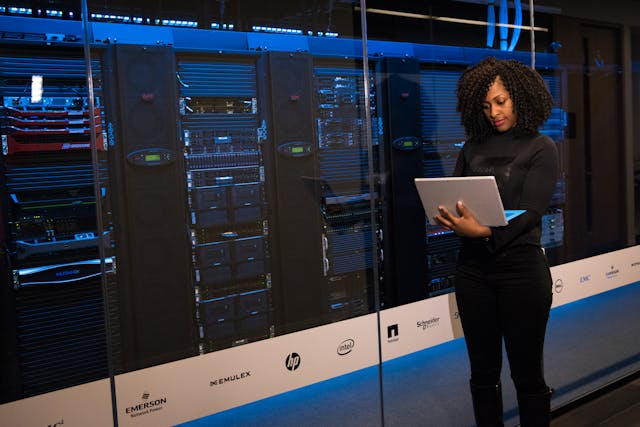MLOps & LLM Ops
Enterprises need robust MLOps and LLMOps systems and processes to ensure optimal functioning of their machine learning and large language model executions. Developers can improve the overall output generated through these solutions by incorporating the right management, training, and maintenance systems.
Enterprises can also accelerate model generation, administration, deployment, and maintenance throughout the lifespan of the adoption of the ML and LLM solutions. Managing large language models, fine-tuning, prompt engineering, and vector database handling can be made that much more streamlined with the right Ops stack and management approach.
What are MLOps and LLMOps?
Machine learning operations (MLOps) & large language model operations (LLMOps), are tools, processes, and techniques to streamline the management and maintenance of machine learning and large language models in production environments.
There may be several challenges in production and launching the machine learning and LLM operations, such as data training issues, compatibility, load times, and server management issues. Enterprises can predict potential areas of collapse and ensure optimal functioning of ML and LLM in practice through Ops mechanisms.
They are vital to advancement of machine learning and large language models, from an operations standpoint, allowing enterprises to benefit from their solutions for wider applications. Firms can operate in a highly structured environment and ensure that their machine learning and large language models function efficiently.
To understand the effectiveness of MLOps and LLM Ops, let's start with the foundation principles of these technologies. Firms can understand the components of each type of system and understand how they can implement them in their own projects.
Foundations of MLOps
MLOps is essentially an optimized approach similar to DevOps, in which the operational side of machine learning applications can be streamlined. Firms can adopt the best practices in MLOps to improve their deployment, management, and maintenance strategies.
Key principles of MLOps
There are several key principles of MLOps that make it effective in helping enterprises manage ML solutions.
-Collaborative development
The most important principle that is driving MLOps adoption across industries is the collaborative aspect. Data scientists, educationists, practitioners, and experts can collaborative to ensure optimal deployment, training, and monitoring across applications.
-Continuous evaluation & training
Continuous evaluation of the machine learning model will be vital for complete adoption. Firms can retrain their data models to ensure that the insights being driven are accurate, precise, and relevant for queries.
-Monitoring is key
Another important element of MLOps tools is the monitoring aspect. Machine learning models and infrastructures need to be monitored for quality, accuracy, latency, and start-up times for optimal results for the specific application.
-Reproducibility
Versioning and ensuring reproducibility will be vital to adopting that pipeline and code-base for other projects. This will help in improving efficiency across ML projects, to ensure compatibility and to draw back features if they're not adaptable.
-Pipeline orchestration
ML projects as well as MLOps practices can be successful when there is pipeline orchestration, which means that the entire pipeline of the deployment is managed through a structured approach. From training to engineering, all aspects of the ML project are trackable.
-Continuous deployment and integration
Branches, models, and versions of ML projects should be deployed and integrated in a continuous manner, without significant down time, latency, or technical stalls. This also includes logging meta data for further learning and retraining implementations.
Important components of MLOps
There are several important components of MLOps that are vital to understand to know the entire process and workflow. This is a general overview of the MLOps component pipeline which can be used by enterprises to enhance their project optimization.
-Data experimentation
The data gathering and experimentation aspect of MLOps is vital to the functioning of the project. Firms need the right tools, policies, and practices to ensure comprehensive data capturing, as well as capabilities for experimentation including hyperparameters, evaluation, etc.
-Data processing
The data processing component of MLOps includes implementing the right encoders, ensuring data batching & streaming, as well as serving and training the right types of data. By having the right data sources and management strategies, firms can improve their ML applications.
-Model development
Development processes, such as data preparation, model training, and hyperparameter tuning are vital to ensuring optimal results. Enterprises need to ensure that their ML models are functioning as well as validated for a range of queries and criterion.
-Deploying
As continuous deployment is a key cornerstone of MLOps, firms need a comprehensive mechanism to ensure rollback, canary deployment, model switching, shadowing, etc. with ease. The right MLOPs tools can help significantly.
-Tracking and monitoring
The tracking of the output generated by the ML model should be a key priority and an important component. The key issues that data scientists can track for include quality, concept shift, distribution shift, and quality degradation.

Foundations of LLM Ops
LLMOps is a key management system for large language model applications, allowing business owners to make decisions based on structured programs. Firms can improve the training, fine-tuning, and overall deployment of large language models through the LLMOps approach.
Understanding key challenges in operationalizing LLMs
As LLMOps emerged from the critical challenges faced by enterprises when adopting LLMs, it is important to explore them through different lenses.
-Unfathomable datasets
The large scale of the potential data sets available for model deployment can lead to a risk of unfathomable datasets. The quality, duplication, and inaccuracy can be addressed with tools such as NearDup and SemDeDup.
-Inference latency
As LLMs operate by tokenization, there is a risk factor of low parallelizability which can lead to higher latency in inference. There are serious efforts dedicated to reduce memory requirements and improve the load efficiency of LLMs in practice.
-Hallucination risk
There may be a risk of inaccurate information presented in the generated response to a query, which is referred to as a hallucination within large language models LLMs. It is vital to train LLMs accurately and to monitor their progression through different criterion.
-Difficulty in fine tuning
Fine tuning can be a challenge when it comes to highly domain specific insights and smaller niche queries. You can also experience a fine tuning response based challenge when the query is complex or multi-sentence based.
Components of LLMOps
Through the risk factors and challenges addressed in the implementation of LLMs, the development of LLMOps was paramount to improve efficiencies. Key processes such as exploratory data analyses, model and pipeline management, data-preprocessing, etc. need to be formalized under the LLMOps protocol.
-Training
From selecting the foundation model to adapting it to the specific requirement, there are a number of processes and stages required to be optimized under LLMOps. Data collection, model review, as well as data pre-processing are vital to the early stages of LLM deployment.
-Fine tuning
The model performance can be further improved through fine-tuning pre-trained LLMs. LLMOps can ensure that the risk of inaccurate information and hallucinations can be minimized through fine-tuning for more complex queries.
-Deploying
By leveraging the practices under continuous integration and delivery (CI/CD) firms can ensure minimal disruption to users, as well as optimal accuracy in responses. Continuous governance also allows for efficient deployment across various applications and industries.
-Monitoring
Ensuring LLM model stability, consistent output, and functional abilities should be tracked through monitoring tools. You can further deliver higher quality models by understanding the model inference output and retraining data based on specific factors.

Data management
Data collection and management is another key area to understand when it comes to MLOps and LLMOps. By knowing what types of data management strategies are important, you can improve your deployment quality as well as enhance query resolution accuracy.
-Data collection & pre-processing
It is vital to acquire pre-cleaned and free from error data from a wide range of data sets. Firms can deploy crawlers, use private data, collect fresh insights & information data sets, and use proprietary data warehouses. Both data preparation and data transformation are vital to the process of training ML systems.
-Versioning & tracking changes
Any changes or modifications in the datasets or machine learning training data should be versioned effectively. Software systems can be introduced to control the various versions of data sets being prepared to ensure optimal quality and maintenance of information.
-Quality assurance & validation
The performance of the ML algorithm is tested across various parameters and iterative tests. This can help provide a clearer picture to data scientists about the validity of the machine learning algorithm. Firms can test multiple types of applications and systems within MLOps and monitor their development over time.
Model development
The model development process is a comprehensive stage within the overall MLOps application development and deployment protocols.
-Model experimentation
Experimentation tracking is a key part of MLOps, helping developers ensure that various machine learning models are working efficiently. Model experimentation requires the collaborative efforts of data scientists and engineers to effectively determine the right code quality, operationalization, and reproducibility.
-Hyperparameter tuning
By understanding the parameters included in the machine learning program, it is important to tune them further. The number of layers using in the neural network can be changed, as well as the weights and biases of the ML model can be adjusted. Hyperparameter tuning can help firms develop a more robust solution for better output.
-Model evaluation
The machine learning model developed needs to be evaluated across multiple parameters to ensure that it can be deployed seamlessly. Firms can input a range of testing parameters to check for output responses, especially in cases where there is no data available, no images present, or no updated information provided.

Deploying models
The model deployment stage is also highly critical to the large language model and machine learning operations. The deployment strategies will also determine how well the production environment is able to capture the necessary requirements from the machine learning application.
-Selecting the right strategy
Through batchML processes, firms can handle larger data sets and prepare their machine learning applications offline for more effective deployment for large-scale use cases. Streaming or realtimeML can be used for improving existing processes and providing real-time predictions for faster machine learning processing.
-Containerization and orchestration
Through containerization, the application and its dependencies, libraries, and configurations, can be encapsulated and deployed with ease on any operation environment. You can package the entire application and have it be iterated upon through the development stages. Through orchestration, ML pipelines can be fully optimized and deployed within a highly structured process, making it a viable part of the overall process.
-CI/CD pipelines
CI CD is vital within the MLOps and LLMOps sphere as it helps in automating many of the process involved in training, deployment, and ensuring reproducibility when it comes to machine learning applications. The CI CD approach can also help in testing, monitoring, and updating ML pipelines to improve the accuracy of responses, predictions, etc. which improves deployment and utility.
Monitoring, scalability & performance
A key aspect of MLOps and LLMOps is to monitor the output generated by ML applications and to ensure optimal results. The focus on quality, algorithmic updating, and response accuracy will help in improving the ability to scale-up machine learning applications, while boosting performance.
-Real time monitoring tools
The model monitoring process is key to improving model performance over time. Real time monitoring tools are vital to enhancing the overall output generated for various applications. Firms can improve their real monitoring, resource utilization, and need for updating training data regularly.
-Drift detection
Detecting deviations from normal responses is another important aspect of managing and deploying ML applications. Answers or predictions can experience deviations when the training data is older, there is something wrong in the algorithm, or there are bugs in new iterations of the ML models.
-Analysing predictive capabilities
MLOps ensures the correct logging and tracking of all ML models, which helps in reverting to older versions if new models aren't effective at capturing complete value. The predictive capabilities can also be improved when there are real time deployments of ML pipelines for improving specific insight generation, such as for forecasting, predictions, and analyses for events.
-Improving model inference
Through model inferencing, the data points can be tested for real world applications prior to launching it at-scale. Model inferencing output can help test live data which can help in understanding the limitations and applications of the machine learning model. Firms can iterate on these applications at-scale, without experiencing significant lag or delays.
-Resource optimization for performance
A key aspect of scalability and performance is the enhancement of resource optimization and addition. It is vital for a machine learning model, under the MLOps and LLMOps protocols, to use the right resources including load managers and DBSM systems, for optimal results and uptime. By investing in resource management, ML applications can be managed synchronously.
Governance for ML models
There are several areas to consider when it comes to governance and compliance to specific MLOps protocols. Ensuring that MLOps tools are transparent in their use-cases, is important to provide more insights to developers and other stakeholders.
-Data privacy concerns
There may be key data privacy concerns within organizations when they're using data sets from across domains and industries. E.g. legal data obtained about certain research & development practices shouldn't be made available for general inquiries by customers or other individuals.
-Updating data sets
Data sets need to be updated to be effective in answering queries and providing a more accurate response within the LLM landscape. There are several LLMOps tools and LLM chaining protocols that would require updating from their training data perspective, depending on the dynamic needs of the customers.
-Model explain-ability (for transparency)
The MLOps paradigm and LLM Ops infrastructure needs to be highly transparent to ensure that there are no hallucinations or responses that are inaccurate. This can help in ensuring that any predictions or forecasting capability of the machine learning model should be tested for ensuring production-ready ML.
Best practices in MLOps and LLMOps
Best practices in the LLMOps and MLOps landscape can help firms improve their model deployment as well as their training data optimization strategies. These LLM MLOps best practices can also provide more insight to project owners to help them improve their model performance and execution.
-Expand datasets
It is important to expand the types and qualities of datasets available to ensure that you're able to provide greater value for queries. MLOps and LLMOps should focus on exploratory data analysis as a core mechanism to improve share-ability for datasets and visualizations.
-Monitor drifts
Potential changes in the predictive ability of the machine learning model can lead to drifts which can cause issues with accuracy and quality. You can have data drifts and concept drifts which would have to be monitored early on to prevent deviations.
-Ensuring reproducibility
A key best practice when it comes to managing ML or LLM operations is using registries and meta data to ensure reproducibility. This can help significantly lower training and development time when adapting MLOps or LLMOps for future projects.
-Enabling CI/CD integration
By adding the tools that ensure CI CD enablement, you can provide a more synchronous and collaborative environment for continuous deployment. Firms can improve their management capabilities for machine learning projects by onboarding a CI CD workflow pipeline based solution.

Future of MLOps and LLMOps
There are several future trends for LLM Ops and MLOps tools, which is why the LLM landscape is expanding steadily. As firms experience greater benefits of LLM and MLOps platforms, developers will also be able to provide more value to future projects based on NLP and LLMs.
-Enhanced retraining
With greater processing capabilities and a structured MLOps and LLMOps environment, there can be scope for enhanced retraining for future versions. Firms will be able to retrain their LLM models faster and for a wider range of data sets for various industries.
-Dynamic development environment
Developers are focusing on a more dynamic development environment which improves collaboration, training strategies, data collection protocols, as well as deployment methodologies. Future iterations of MLOps and LLMOps will focus on more efficient data management in a dynamic environment.
-Enhanced integration
There will be greater integration with containers, orchestrators, and serverless systems for a more streamlined pipeline for ML and LLMOps. Operational efficiencies will drive further integration and better cloud-agnostic deployment.
-Greater monitoring capabilities
To lower cost of production as well as improve efficiency, future versions of MLOps and LLMOps will focus on greater oversight and monitoring capabilities. New tools will make it easier to improve operational efficiencies, as well as overall management of project deployment.
FAQs
How can we train machine learning applications better through MLOps?
Model training is automatically executed when there is a new data set present or there are changes in the data sets for the machine learning application. Firms can use MLOps processes, tools, and ecosystems to help improve ML output through iterative stages and automated pipelines.
What is model metadata storage and processing?
Model metadata is generated through every stage in the process of production running the application. There is data generated about the pipeline components, their training runs, and the artefacts generated. These need to be stored and processed for optimal functioning and debugging on new and previous code.
What are feature stores and model hubs in MLOPs?
Data that is processed from multiple sources can be turned into features for consumption by the model training pipeline. Feature stores can be used by multiple teams and can help centralize and manage production data. Model hubs can help save a trained model's parameters for future projects.
What is model observability? How often should it be performed?
ML observability is the best way to understand where core problems may be present within ML models through a comprehensive process. Through the time to detection and time to resolution process, ML observability can help fine-tune an application and provide insights about bugs immediately.